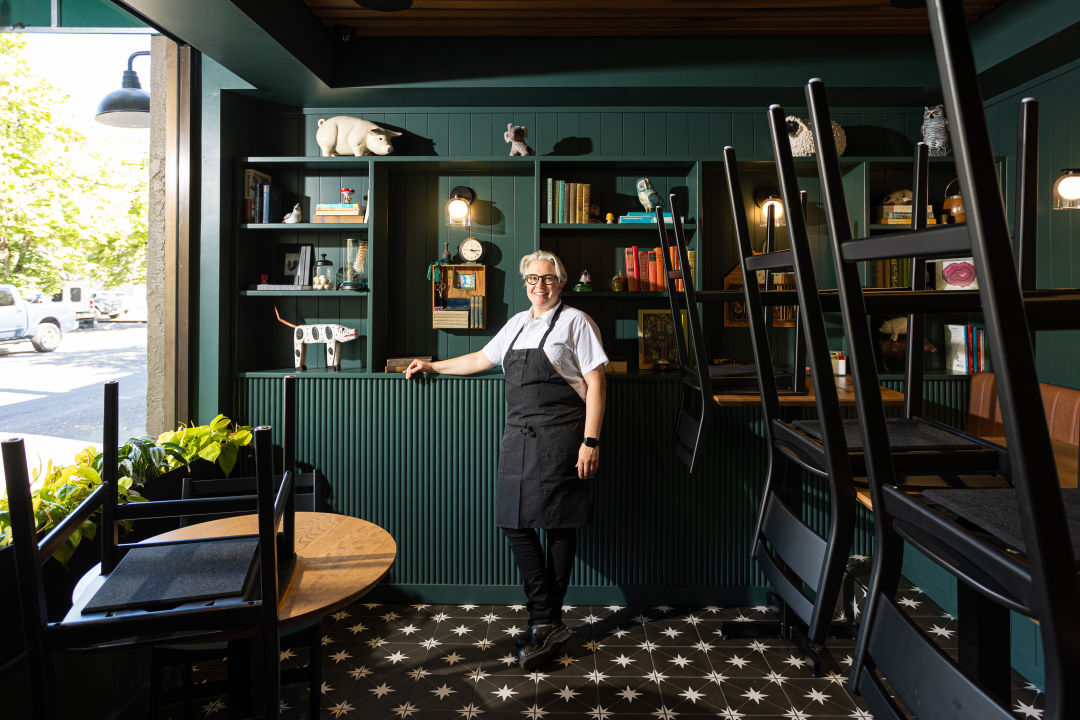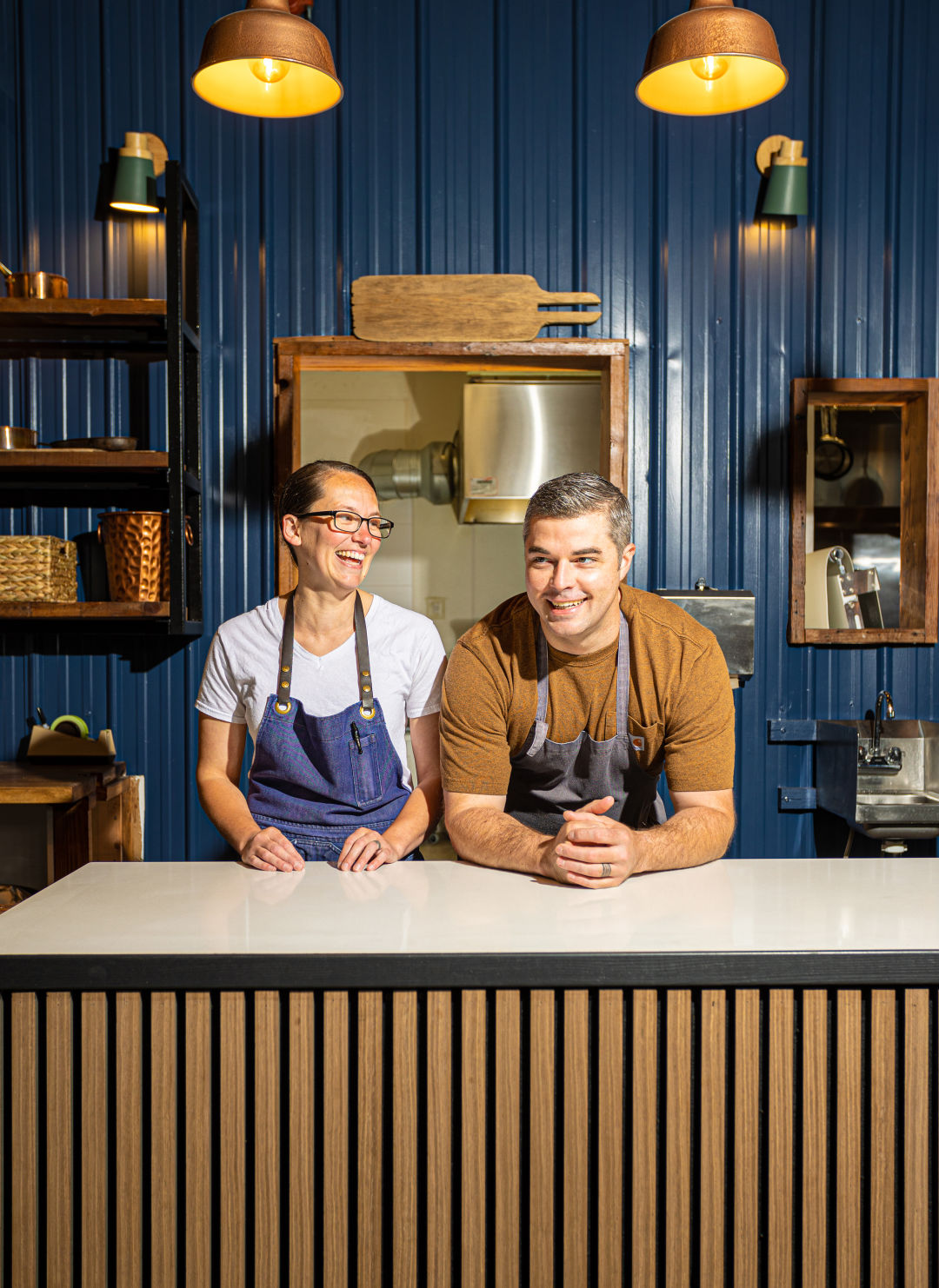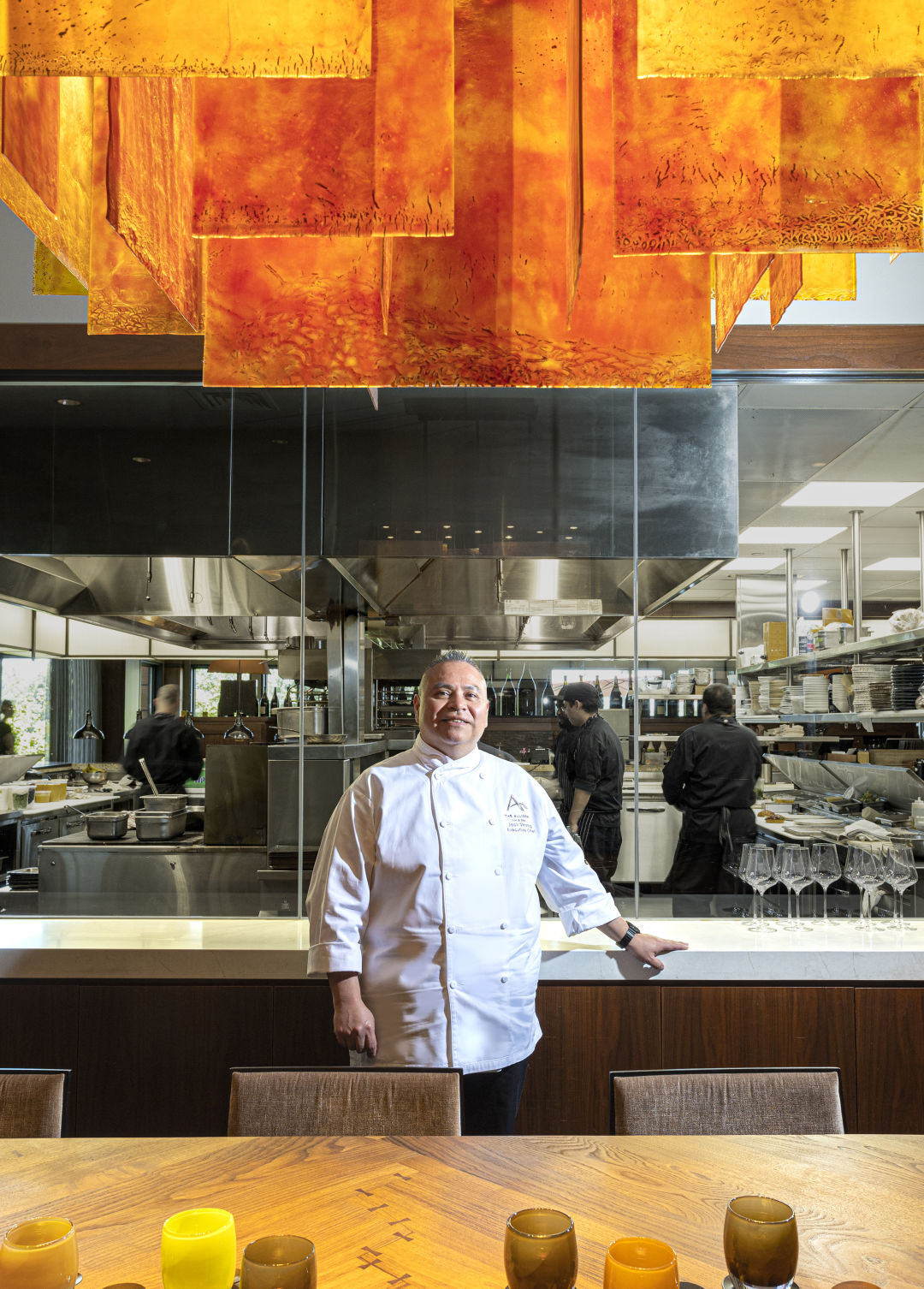The Best Chefs of Oregon’s Willamette Valley

At the Pub and Grounded Table, chef Sarah Schafer pulls inspiration—and ingredients—from the restaurant group’s own Willamette Valley farms.
For decades, the restaurants and bars of Willamette Valley wine country told a specific story about what local food looked like here. An amorphous descriptor, “local” to the Willamette Valley mainly referred to Oregon-grown ingredients brought to the state by American settlers of European descent, things like hazelnuts, pears, even wine grapes themselves. And those ingredients—as well as ones truly native to the Pacific Northwest, like Chinook and chanterelles—were often presented in a European context, most often French or Italian. Thus, some culinary tropes developed within the wine country restaurant, which now feel (perhaps unfairly) dated: hazelnut and pear salads with Rogue Creamery blue cheese, pastas or risottos with truffles or morels, cedar plank salmon, desserts dotted with marionberries or Oregon hood strawberries, depending on the time of year.
But as the Willamette Valley grows, attracting chefs from cities like Portland or culinary destinations like Napa, the way chefs think about local food has expanded, shifted. For chef Jack Strong at the Allison Inn & Spa, serving local food means using both produce grown in the hotel’s garden and Native foods long foraged and fished by Willamette Valley area tribal communities. “Farm to table” is far more than a metaphor for Grounded Table’s Sarah Schafer; she’ll wander her restaurant group’s vegetable plots while designing dishes. All the while, chefs like Kari Shaughnessy or Haley and Brendan Byer are presenting Oregon-grown fruits and vegetables with the help of a global pantry, leaning on Japanese and Tunisian flavor profiles, to name a few. And, while many of these restaurants are clearly designed for a tasting menu format, others are intentionally approachable, be it a bakery serving smoked steelhead–topped bagels or a pub smoking meatloaf and portobello mushrooms. And so, dining in the Willamette Valley has become seriously fun, offering a new story—homages paid, but wholly original.
Sarah Schafer, Grounded Table and the Pub
Before she began smoking meatloaf at the Pub in McMinnville, before she started rolling pasta dough at sibling restaurant Grounded Table, and even before she was frying chicken at her former Portland restaurant Irving Street Kitchen, Sarah Schafer worked at some of New York’s most famous Michelin–starred restaurants—Gramercy Tavern and Eleven Madison Park. But she left it behind to move to Portland, to serve unfussy food with the tells of a high-end chef’s pedigree; pig’s head croquettes are “tater tots,” for instance. Eventually, she landed in the Willamette Valley to steer the kitchen at the nonchalantly elegant restaurant Grounded Table (formerly known as Humble Spirit) and, as of 2025, its new sibling cocktail bar, the Pub. Both exist within the universe of the multifaceted, farm-fueled hospitality group the Ground. The hope, in her words, was to “walk the walk” of farm-to-table cooking.
And walk it she does, traipsing through the Ground’s own farms, peeping spring peas and late-season Jimmy Nardello peppers to scheme dishes. Since Schafer took over the kitchen at Grounded Table in 2024, she’s kept a fierce grip on the driving ethos of the restaurant— nothing overly pretentious, always rooted in deliciousness—while making it her own. Opening the Pub, she gave Grounded Table’s more casual bent its own dedicated space, even adapting the cacophonously crispy fried chicken she developed at Irving Street Kitchen for a sandwich with farm pickles. In turn, Grounded Table has more room to breathe, owning its grace and sophistication without losing its nostalgia. In the spring, pasta with ham and peas came with housemade cavatelli, a classic combo elevated with a judicious touch of fresh mint; meadowlake hay custard with fennel and rhubarb conjured spring mornings in the backyard, evocative but not obvious. “I want to be soulful,” Schafer says, “but I want to add some elegance.” —Brooke Jackson-Glidden

Napa expats Haley and Brendan Byer apply Michelin–starred culinary technique to pastries and café fare at Alea.
Haley & Brendan Byer, Alea
Wild yeast fueled Haley and Brendan Byer’s love story, first sparked in the kitchen of a Napa restaurant. They connected by comparing notes over sourdough starters and, later, made late-night loaves—post–dinner service for Brendan and pre–baking shift for Haley. Now, the fruit of their fermentation-fueled partnership is on the menu at their buzzy new bakery and café in McMinnville, Alea.
Their Napa Valley heavyweight credentials—Brendan cooked at three-Michelin-star SingleThread Farm, Haley folded boules at wood-fired sourdough temple Della Fattoria—caught the eye of the original Okta, and the couple headed north to become the destination tasting menu spot’s chef de cuisine (Brendan) and head baker (Haley). But Alea, which began as a pop-up before moving into McMinnville’s Mac Market, marks a tonal shift. The breakfast-lunch menu is not after Michelin stars. Instead, it’s full of familiar forms reinvented with exceptional ingredients: Think bagels encrusted in smoky Japanese sesame seeds, coffee cake streaked with winey haskap berries, tender tamago-style omelets lined with nori and served with pickled mushrooms. Their pastries and breads are nourishing and alive—deeply flavored with long-fermented Cairnspring and Camas Country grains.
Still, Alea’s isn’t your average coffee shop spread, and that’s the point. The Byers are baking an ethos: one rooted in technique, but also in place. Foraged sea vegetables, locally raised duck, and line-caught albacore appear not only at their occasional evening pop-ups and winery events, but also in breakfast pastries and sandwiches. Their food holds a kind of romantic stubbornness, a commitment to a shared vision—and, one early morning and late night at a time, sees it through. —Emily Teel

Kari Shaughnessy opened her restaurant Hayward within a McMinnville food hall. Now, she and the restaurant have graduated to a spacious and stylish space in Carlton.
Kari Shaughnessy, Hayward
Since it opened in its original location in 2023, at McMinnville’s Mac Market food hall, Kari Shaughnessy’s surprisingly intimate restaurant has wowed not just wine country, but also the rest of the country. Her globally inspired menu, which tethers tightly to Oregon farmers and ranchers, has landed Shaughnessy as a James Beard Award semifinalist twice in as many years, and she’s pushed the Willamette Valley’s food scene perhaps more than any other chef in the region. She brings an ambitious but casual approach reminiscent of her alma mater, Melissa Perello’s San Francisco restaurant Frances, to a landscape of special-occasion tasting menus and wine snacks. Carrot cavatelli get a spike of fermented leeks and carrot curry paste. Toothsome semolina pasta gets a kick of harissa made with chiles fermented in-house. She cultures her own koji butter to serve alongside focaccia (she started out as a baker). “I want those to be able to exist at the same time,” she says, “on one menu.”
Hayward’s cuisine evades labels, but its basis in local ingredients that nod to Oregon wine pairings goes far past the expected salmon, hazelnuts, and chanterelles. Spring menus burst with fioretto cauliflower, cruciferous greens, and blink-and-miss-them farmer’s spoils, while winter menus hunker down with root vegetables and a well-kept larder, tangy jarred peppers and alliums breathing life into sauces and pickles lending a bright crunch.
Originally from Massachusetts, Shaughnessy spent her twenties in heralded bakeries and Michelin-starred restaurants in Boston and then San Francisco. Burned out on city life, she turned to Oregon wine country for a change of pace. Naturally, she carried that scrappy ingenuity into setting up her own restaurant. Shaughnessy and Hayward along with her are constantly iterating. In fact, this year, Hayward outgrew its Mac Market digs and moved to Carlton’s small-but-mighty dining scene. Which prompts the question: After all that, what can Shaughnessy do with a stand-alone restaurant? —Alex Frane

Siletz tribal member Jack Strong came up in hotel restaurants around the country. Now, he’s folding Indigenous culinary traditions and ingredients into his luxe Allison Inn & Spa tasting menus.
Jack Strong, the Allison Inn & Spa
Under a seared breast and tiny confit leg of squab, an ultrasavory puree of elephant garlic and acorn swirls with a violet-hued huckleberry jus. The dish, one of the early courses in chef Jack Strong’s tasting menu at Newberg’s Jory, is reprised later in the meal, as a huckleberry popsicle placed alongside a sip of huckleberry tea. In addition to being an iconic ingredient of Anglophone Pacific Northwest culture, Strong says, “huckleberries are really a prize possession of Native foods in the Northwest.” And in that overlap, Strong finds a way to connect across cultures, adding a deeper layer to the now-
ubiquitous concept of “local food.”
How clearly you can see the Native influence on the menu at Jory, the Allison Inn & Spa’s celebration restaurant, is intentionally flexible. The restaurant offers a Native foods tasting, in which Strong builds a menu inspired by tribal culinary traditions, abundant with context and history. But even beneath the standard, European-influenced tasting menu lies Strong’s rich Indigenous culinary repertoire. Fort Klamath sturgeon sports a green garlic velouté, paired with sunchokes and fiddlehead ferns commonly eaten by groups like the Cowlitz and Lower Chinook.
Strong is a veteran of the hotel restaurant biz who knows his way around a room service menu and wedding banquet. But the born-and-raised Oregonian and member of the Siletz Tribe is also a national leader of the Indigenous food renaissance, having worked at Arizona’s lauded Native restaurant Kai and coauthored The New Native American Cuisine. All of those facets of his personal history converge at Jory. Strong’s canny blending of influences and context showcase foods consumed by Turtle Island tribes since time immemorial and foods common in the Willamette Valley today. Often, they’re one and the same. “We’re highlighting place,” he says. And in a way few chefs have managed. —BJG

Fresh off a James Beard Award win, chef Timothy Wastell has turned the food pairings at lauded winery Antica Terra into destination dining.
Timothy Wastell, Antica Terra
Timothy Wastell didn’t think the James Beard Awards applied to “nonrestaurants.” One of Oregon’s most-sought-after meals, the afternoon tasting menu he serves at celebrated wine mystic Maggie Harrison’s Amity winery, Antica Terra, began like most vineyard food: a supporting cast of snacks, harvest meals, and one-off dinners. But, slowly, since 2016, it’s grown alongside the winery into a refreshingly enjoyable take on fine dining, securing Wastell a Beard this year. “It’s funny,” he says, “Maggie called it a restaurant the other day.”
After stints at Paley’s Place and DOC in the aughts, Wastell made his name cooking at fleeting, farm-adjacent events. Before Antica Terra began its regular lunch service last summer, at its new Barrel Hall tasting room, you had to catch him cooking at dinner series like Outstanding in a Field or at Big Table Farm, or events with the Culinary Breeding Network. Logically, local agrarian spoils are queen of his tasting menu and the seasonal dinners Wastell serves on the winery’s 200-foot-long “Table in the Trees.” But foie gras, Burgundian truffles, Osetra caviar, and other sequined imports have their place.
Plates are refined versions of recognizable recipes, and often shareable and interactive. Crudités are a signature. “A love letter to farmers,” Wastell calls them. More than anything, the bouquets of a dozen or so raw radicchios, brassicas, and berries showcase his extraordinary knack for sourcing—an edible ready-made. You might also find steak frites, an onglet in sticky jus with a handsome slab of seared foie gras showered with black truffles. The mode is locavorism tinted with an affinity for starchy, grand fine dining, by turns lightly ceremonious, nourishing, and fun. Restaurant or not, it’s hard to think of another winery, down a gravel road miles from much of anything, where sober folks book reservations weekly. “Yeah,” Wastell concedes, “we’re kind of a restaurant.” —Matthew Trueherz
Share this content:















Post Comment